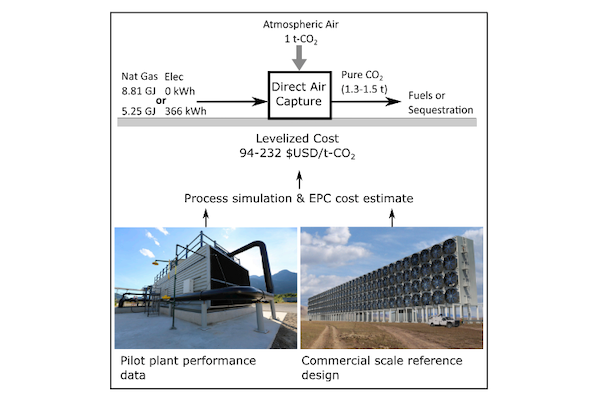
Carbon engineering
I founded Carbon Engineering (CE) in 2009 to develop technology for capturing CO₂ from ambient air. This was an unusual choice for me because I’d spent my career in academia and had no business experience nor any strong interest in becoming an entrepreneur. Amazingly, this company grew from a few employees to over 160 when it was bought in November 2023 by Oxy Low Carbon Ventures at a valuation of $1.6 billion. I am no longer involved with CE nor do I have any financial interest in CE or Oxy.
It all started with skepticism. In the late 90’s, Klaus Lackner started publishing on direct air capture (DAC) to counter climate change. Klaus and I shared a physicist’s love for first-principles thinking and a drive to tackle climate, but I thought Klaus was overly optimistic about the cost of DAC. It seemed implausible that it made sense to capture carbon from the air—which is only 0.04% CO₂—when my own work on Carbon Capture and Storage (CCS) was revealing the challenges of attaining cost-effective capture from the 15% CO₂ stream of a coal-fired power plant.
With colleagues at CMU’s Department of Engineering & Public Policy, I started assessing the cost and feasibility of DAC—not to develop DAC technology but rather to inform climate policymakers about its cost-effectiveness. But you can’t do cost calculations without having a specific industrial design to assess. We started with Klaus’ aqueous calcium-looping design and began mapping out a DAC design in sufficient detail to support cost estimation. We made maximal use of existing industrial processes since they provided the only firm foundation for costing.
That effort accelerated in 2007, after I moved to Calgary to join the UCalgary faculty and got funding from Bill Gates for innovative climate work. I hired a few engineers, and we started developing a process model. The low concentration of CO₂ in the air demands a cheap system for bringing huge quantities of air into contact with the capture solution. We evaluated ideas from modified cooling towers to outdoor ponds equipped with electrostatically confined sprays and eventually settled on designs adapted from forced-draft cooling towers, the ubiquitous air handling systems that blow air over wetted surfaces. UCalgary was a great place to work on this project since many colleagues had engineering expertise that straddled the academic and industrial worlds.
By the summer of 2009, we had a rough design, but were painfully aware of our inexperience as process engineers, so we looked for a constructive critic. Bob Cherry, who was visiting from the Idaho National Laboratory, had the perfect background: practical commercial expertise plus an amused tolerance for academics like me. I invited Bob to spend part of that summer beating us up. Bob found lots of problems; but by the end of the summer, he sat in my office telling me there was nothing fundamentally crazy about the design and no reason not to start a company to develop it.
Bob’s nudge was the spark that gave me the confidence to try. It was a blow when Bob died in the Fall of 2023, just weeks before the CE-Oxy deal closed.
My decision to form a company was made easier by the fact that I was struggling in my day job. I’d been recruited to UCalgary to help lead its Institute for Sustainable Energy, Environment, and Economy (ISEEE). Calgary is the capital of the Canadian oil patch, and ISEE was intended to stimulate constructive interactions among oil industry leaders, policymakers, and environmentalists. But ISEEE was floundering because UCalgary was unable to manage conflicts between industrial and environmental interests.
With no idea how to form a company, I spent a lot of time knocking on the doors of folks who did. That effort culminated in a meeting that included Julio Fredman and Peter Eisenberger, who would both go on to play important roles in DAC technology; and Michael Brown, a leading Canadian clean-tech venture capitalist who urged me to start CE but not to accept VC funding. The first investment round was $3m Canadian in October 2009.
I ran CE for the next five years without quitting my academic work, but with long periods when CE consumed most of my mental energy. We hired Adrian Corless as our first CEO in 2014. I then served as a board member and technology advisor until the sale in 2023. Now I am thrilled to be a bystander watching ideas turn into hardware as CE’s partners build a plant that will capture half a million tons per year of carbon dioxide from the atmosphere.
CE was an extraordinary education in the challenges of developing practical technology in the cleantech industry. CE sharpened my taste for applied work. I loved the problem-driven teamwork of the startup environment. But the secrecy required in business renewed my love for the openness of academic research. The world needs better ways to combine the teamwork of a startup with the openness of academia. The depth of engineering and business expertise outside the academic walls was humbling. Academics too often imagine translational research as a one-way process that turns academic research into practice and too often ignore the deep wells of applied science expertise outside academia. Translational research works best when it’s bidirectional.


Why Capture CO₂ From The Atmosphere
A Process for Capturing CO₂ from the Atmosphere
The Economist: David Keith on why carbon removal won’t save big oil but may help the climate